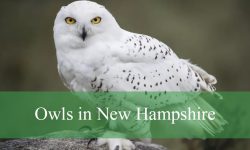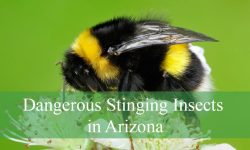When you spot a bird with dark plumage and a distinctly brown head, it might leave you wondering what species it could be. Across different habitats and regions, there are several fascinating black birds with brown heads, each with its own unique traits and behaviors. Some are easy to recognize thanks to their vivid contrast in coloring, while others require a closer look to identify.
This guide highlights 14 striking examples of a black bird with brown head, complete with pictures and identification tips to help birdwatchers and nature enthusiasts distinguish them in the wild. From common backyard visitors to tropical rainforest dwellers, these birds vary widely in size, song, and habitat.
Whether you’re an experienced birder or a curious beginner, learning to identify black birds with brown heads can deepen your appreciation for avian diversity. Read on to explore these captivating species and find out where you might encounter them.
Different Types of Black Birds with Brown Heads
Brown-headed Cowbird (Molothrus ater)

The Brown-headed Cowbird is a small blackbird known for the stark contrast between the male’s glossy black body and its rich, chocolate-brown head. Females, in comparison, are smaller and lack the striking coloration—displaying a uniformly dull brown plumage. This species has a short, conical bill and a somewhat rounded body typical of other cowbirds.
This bird is infamous for its brood parasitism behavior. Females lay their eggs in the nests of other bird species, leaving the host to raise their young. Despite this, Brown-headed Cowbirds are widespread and have adapted well to human-altered landscapes. Their songs are bubbly, liquid-like sounds that can be heard in open areas.
They are commonly found throughout North America, especially in open woodlands, grasslands, and agricultural fields. They often forage near cattle or other large animals, feeding on seeds and insects stirred up by hooves. They are year-round residents in the southern parts of their range but migrate in the north.
Chestnut-headed Oropendola (Psarocolius wagleri)
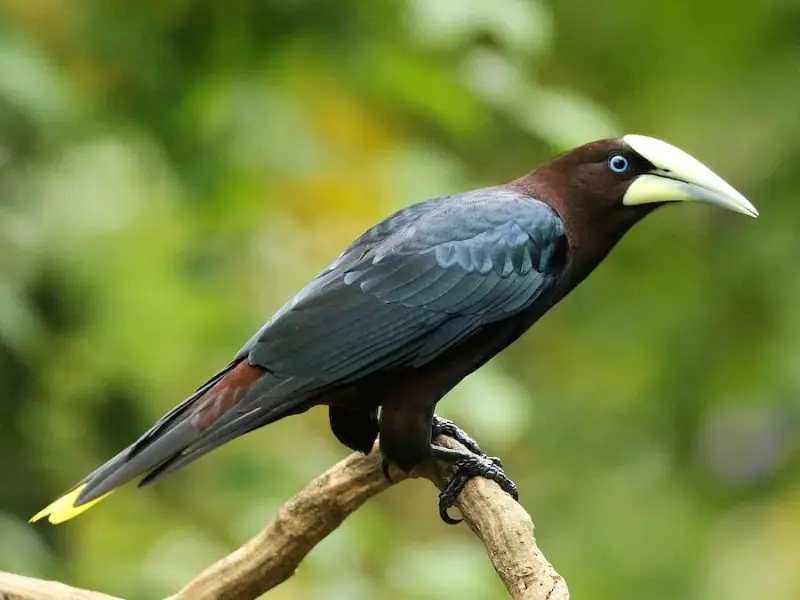
The Chestnut-headed Oropendola is a stunning tropical bird with a rich chestnut-brown head and a contrasting black body. Its tail feathers are a brilliant yellow, creating a striking visual when in flight or perched. This bird also has a pale blue eye and a strong, pale bill, further adding to its dramatic appearance.
Known for its complex vocalizations and colony nesting behavior, the Chestnut-headed Oropendola often builds long, pendulous nests that dangle from tall trees. Males are polygynous and compete for mates within colonies, producing gurgling and bubbling calls that echo through the forest. These birds are often seen in the canopy, foraging for fruits, insects, and nectar.
They inhabit tropical rainforests across Central America, ranging from Honduras to Panama. Their preferred environments are lowland forests, forest edges, and sometimes plantations near forested areas. Though still relatively common, habitat loss poses a potential threat to their long-term population health.
Bronzed Cowbird (Molothrus aeneus)
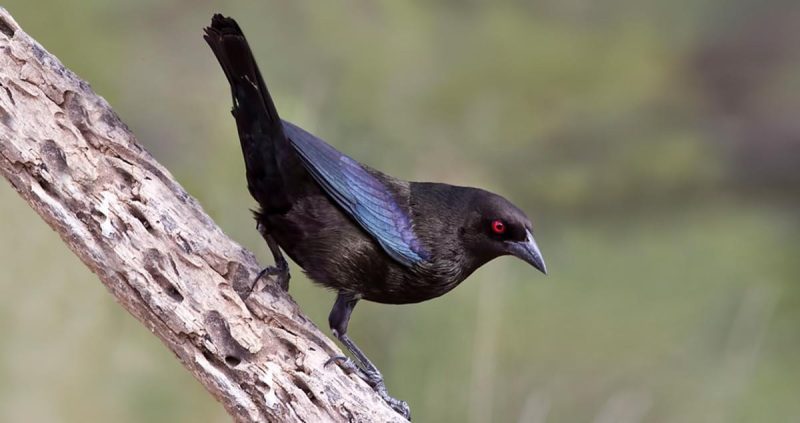
The Bronzed Cowbird stands out with its stocky build, thick neck, and intense red eyes. The male’s plumage is an iridescent black that shimmers with bronze tones under sunlight, especially on the head and upper body, giving it its common name. Females are much less colorful, typically a dull brown all over, helping them stay inconspicuous during nesting.
Like its relative the Brown-headed Cowbird, this species practices brood parasitism. Females lay eggs in the nests of other birds, often outcompeting the host’s offspring. Their vocalizations are harsh and metallic, lacking the musical tone of some songbirds, but still recognizable.
Bronzed Cowbirds are found in the southwestern United States, Mexico, and much of Central America. They thrive in grasslands, pastures, and farmlands, especially where livestock are present. These birds are often seen foraging on the ground for seeds, grains, and insects stirred up by grazing animals.
Black-headed Grosbeak (juvenile males) (Pheucticus melanocephalus)
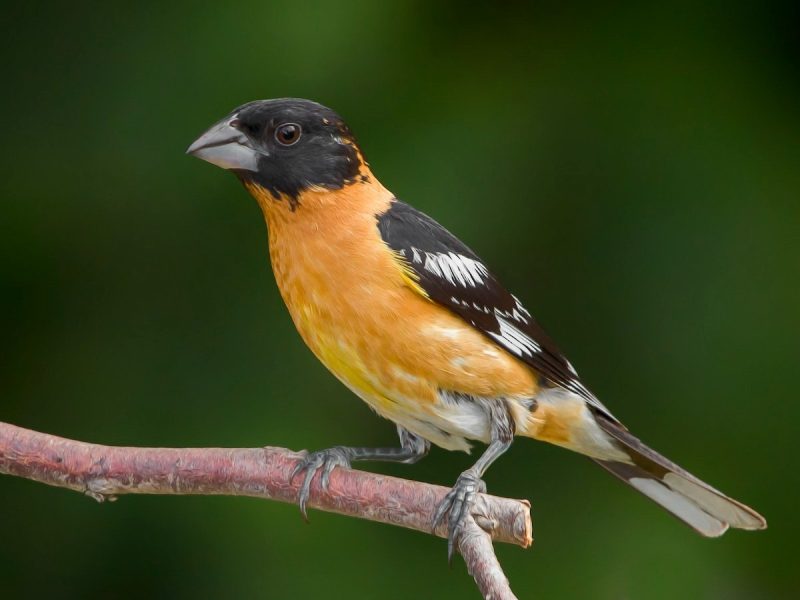
Juvenile male Black-headed Grosbeaks sometimes exhibit a brownish tinge on the head as they molt into their mature adult plumage. Adult males are typically bold and striking with a black head, orange chest, and white patches on the wings, while females are streaky brown and buff-colored. During their first year, immature males can be mistaken for a different species due to this transitional coloring.
This bird is a skilled singer, producing rich, warbling notes that can sound similar to an American Robin but more fluid. It feeds on a varied diet that includes insects, fruits, and seeds, and it has a particularly strong beak adapted to cracking open tough seeds and even snacking on monarch butterflies—one of the few birds known to tolerate their toxins.
Black-headed Grosbeaks are found across the western regions of North America, especially in forested habitats near streams and rivers. They prefer riparian woodlands, mixed forests, and residential gardens with plenty of cover and food sources. Many migrate to Mexico and Central America during winter months.
Black-bellied Whistling Duck (juvenile) (Dendrocygna autumnalis)
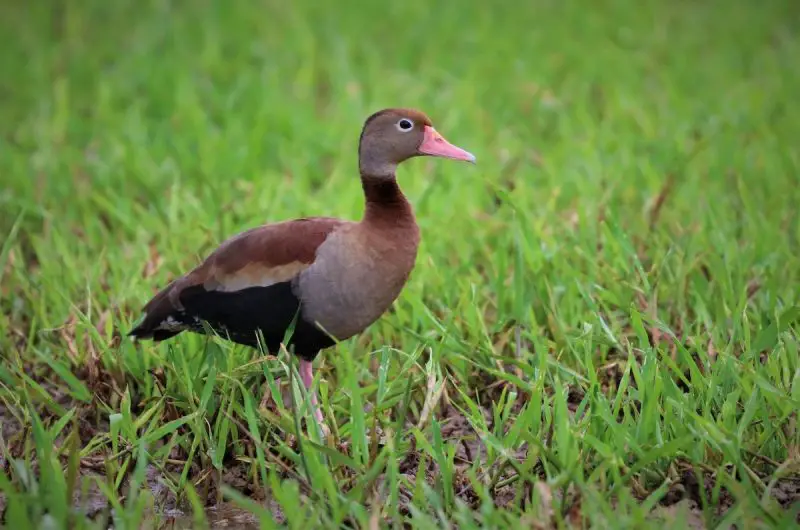
Juvenile Black-bellied Whistling Ducks often show a striking contrast between their dark, nearly black bodies and duller, brownish heads. This coloration gradually transitions into the adult plumage, which features a chestnut body, black belly, and bright pink bill and legs. The overall posture of the bird is upright and goose-like, making it quite distinctive even in its juvenile form.
These ducks are highly vocal, producing a clear whistling sound that gives the species its name. They are social birds, commonly found in pairs or small flocks, and often roost in trees or nest in cavities—an unusual trait for ducks. Juveniles can frequently be seen following adults closely as they learn to forage.
The species ranges from the southern United States through Mexico and into Central America. It prefers freshwater wetlands, marshes, and shallow ponds, often near agricultural fields. Their adaptable nature allows them to thrive in urban parks and artificial wetlands as well.
Rusty Blackbird (winter male) (Euphagus carolinus)

In winter, male Rusty Blackbirds lose their glossy black breeding plumage and develop rust-colored feather edges, giving their head and body a brownish appearance. This seasonal transformation is key to identifying them during colder months, when their appearance can differ drastically from the sleek black coloration seen in spring and summer.
Rusty Blackbirds are known for their subtle, gurgling calls and relatively shy demeanor. They feed on insects, seeds, and small aquatic creatures, often flipping over leaves and debris in wet, boggy areas to uncover prey. Their population has sharply declined in recent decades, making sightings increasingly rare.
These birds breed in boreal forests across Canada and Alaska and migrate to the southeastern United States for winter. During migration, they frequent wet forests, flooded fields, and forested swamps. Conservationists are currently monitoring their habitats closely due to concerns about rapid population loss.
Grackle species (juvenile or molting)
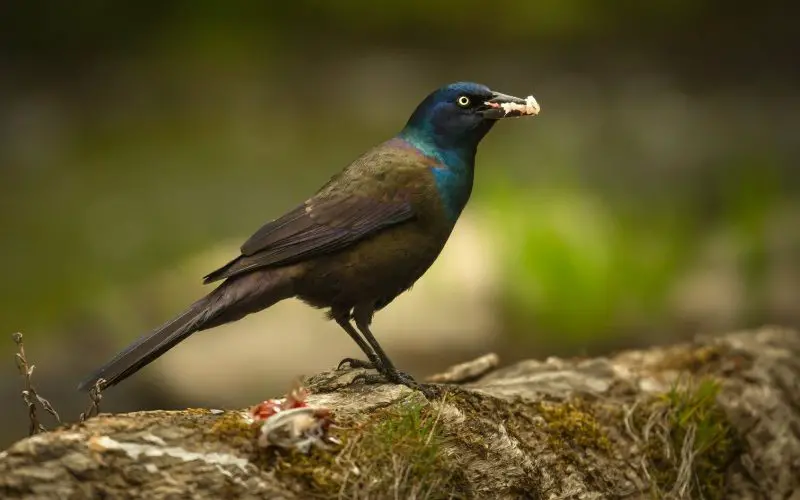
Juvenile or molting individuals of grackle species, such as the Common Grackle or Great-tailed Grackle, can sometimes display a unique combination of a blackish body with a brown-tinged or faded-looking head. This transitional plumage is particularly noticeable when birds are molting out of juvenile feathers or preparing for the breeding season.
Grackles are intelligent, opportunistic foragers often seen in large, noisy flocks. They have long legs and tails and are known for their iridescent plumage in adulthood, which can shimmer in blues, purples, and greens depending on the species. Young or molting birds may appear more subdued in color but retain the same bold, curious behavior.
These birds are widespread across much of North and Central America. They thrive in open habitats such as fields, urban areas, and wetlands. Grackles often congregate near human activity, scavenging for food and forming large communal roosts in trees or urban structures.
Tricolored Blackbird (Agelaius tricolor)
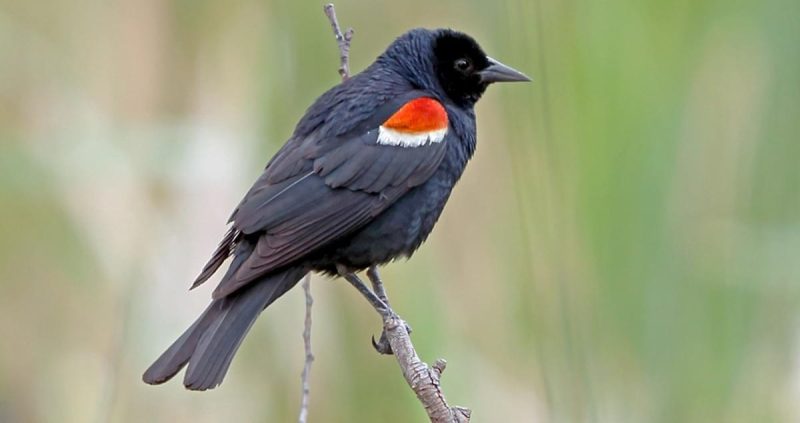
Tricolored Blackbirds resemble Red-winged Blackbirds but can be distinguished by the white edging on their shoulder patches instead of yellow. In some molting individuals or juveniles, the head may take on a dark brown hue, leading to occasional confusion with other blackbird species during certain stages of development.
These birds are known for their colonial nesting behavior, often forming massive breeding colonies that can include thousands of individuals. Males produce sharp, buzzing calls while guarding territories, while females build cup-shaped nests in thick vegetation. The species is highly dependent on wetland and grassland habitats during the breeding season.
Tricolored Blackbirds are primarily found along the western coast of the United States, with most populations concentrated in California. They breed in grasslands, dairy pastures, and rice fields, especially where dense vegetation provides nesting cover. Conservation efforts are ongoing to protect their dwindling numbers due to habitat loss.
Dusky Moorhen (non-breeding plumage) (Gallinula tenebrosa)
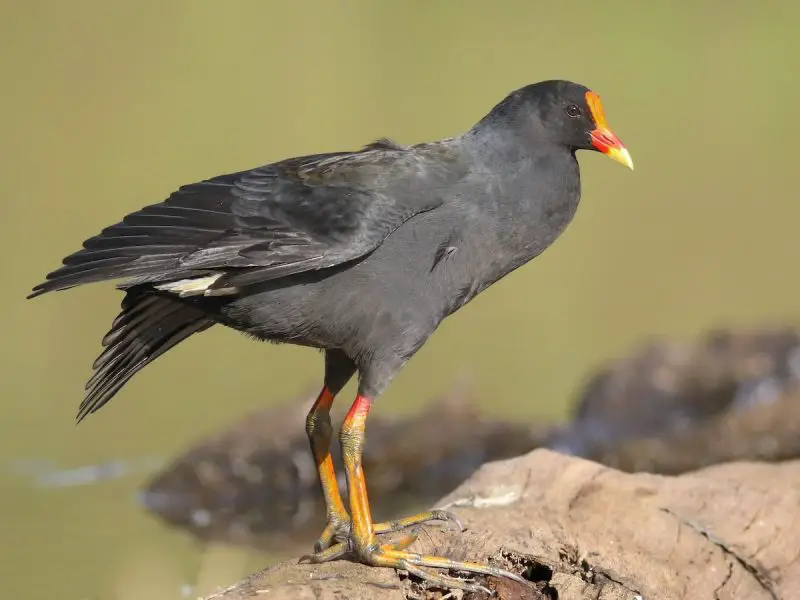
In non-breeding plumage, the Dusky Moorhen can take on a slightly browner appearance on its head, contrasting with the otherwise dark gray to blackish body. The usual vibrant facial shield becomes duller outside the breeding season, adding to the more subdued overall look. This seasonal variation can make the bird appear less striking than during peak display periods.
These waterbirds are commonly seen walking along the edges of wetlands or swimming in open water, often in groups. They have a somewhat jerky walking motion and flick their tails frequently, revealing white under-tail feathers. Despite their chicken-like build, they are agile in water and often feed on aquatic plants and invertebrates.
The Dusky Moorhen is widespread across Australia, Southeast Asia, and parts of the Indian subcontinent. It thrives in freshwater wetlands, lakes, ponds, and marshes, often adapting well to urban parks and manmade water bodies. These birds are permanent residents in many areas and do not migrate extensively.
Brown-capped Rosy-Finch (Leucosticte australis)
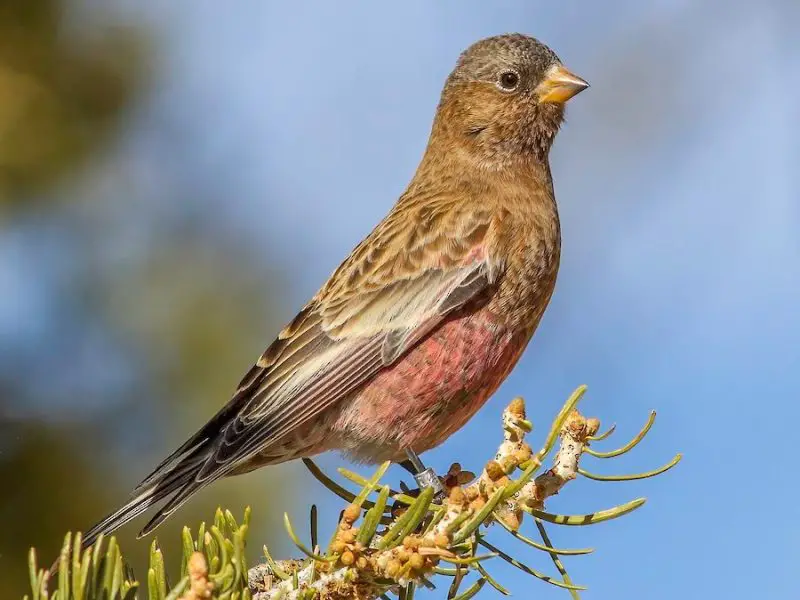
The Brown-capped Rosy-Finch is a high-elevation bird with a dark, earthy-colored body and a distinctive brown cap. Although not entirely black, its overall plumage is deep and rich in tone, which can appear almost black in certain light. The contrast between the brown head and the darker wings and back makes this species easy to identify among North American finches.
This hardy bird is specially adapted to alpine environments, often seen hopping among rocks and snowfields in search of seeds and insects. During the breeding season, it nests on rocky ledges or cliff crevices, where it is safe from predators. Outside of the breeding season, these finches may form flocks and descend to lower elevations.
Brown-capped Rosy-Finches are endemic to the high mountains of Colorado in the United States. They inhabit talus slopes, tundra, and snowfields at elevations above the tree line. Their highly specific range and sensitivity to climate shifts have made them a species of concern for conservationists.
White-collared Blackbird (male) (Turdus albocinctus)
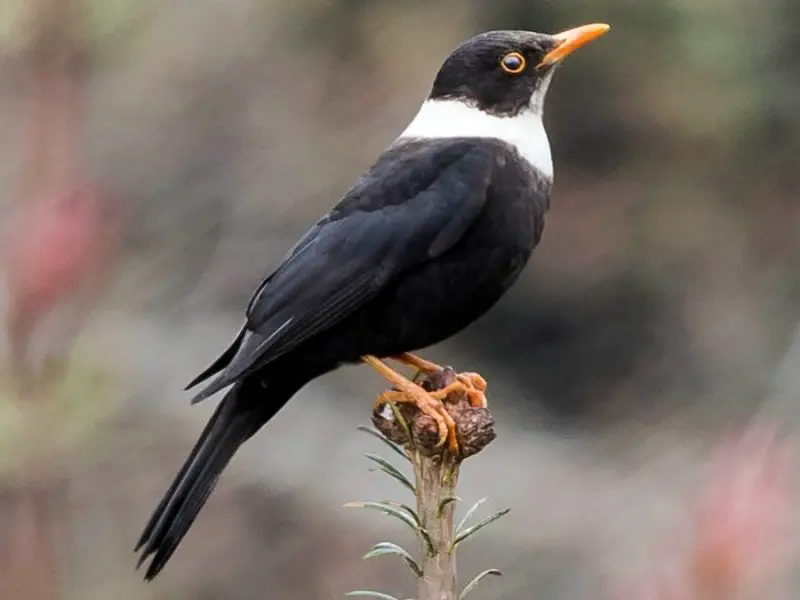
The male White-collared Blackbird presents a mostly black body accented by a bold white collar around its neck. Its head can have a slightly browner or paler tone compared to the rest of the body, particularly in younger birds or during certain times of year. This subtle contrast, along with the white collar, gives the bird an elegant and distinguished look.
This thrush species is known for its rich, melodic song and shy nature. Males often sing from concealed perches within the forest understory. They feed on a mix of insects, berries, and other small fruits, foraging among leaf litter and low shrubs. Despite their dark coloration, they can be surprisingly hard to spot in dense forested habitats.
White-collared Blackbirds are found in the Himalayan regions and southwestern China, where they live in montane forests and alpine shrublands. They favor elevations ranging from 2,000 to 4,000 meters and are most commonly observed in mossy woodlands and rhododendron thickets.
Bay-headed Tanager (Tangara gyrola)

The Bay-headed Tanager is a vibrantly colored tropical bird, easily recognized by its chestnut-brown head, contrasting with a bright green body and striking bluish wings and tail. This combination of colors gives it a jewel-like appearance, particularly when viewed in dappled sunlight among rainforest foliage. Both males and females have similar plumage, making them easy to identify in the field.
These tanagers feed primarily on fruits, nectar, and insects, often seen hopping among branches or flying in small mixed-species flocks. They are known for their shy nature, usually sticking to the middle canopy level of forests, where their brilliant plumage blends in surprisingly well with their surroundings.
Native to Central and South America, Bay-headed Tanagers are found in countries such as Costa Rica, Panama, Colombia, and parts of Brazil and Venezuela. They inhabit humid tropical forests and woodland edges, preferring areas with abundant fruit-bearing trees and shrubs.

